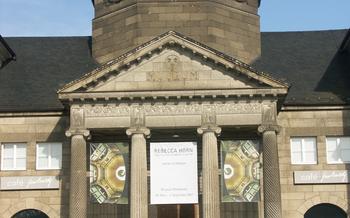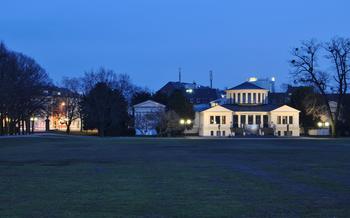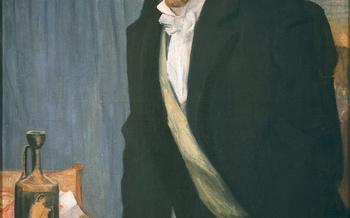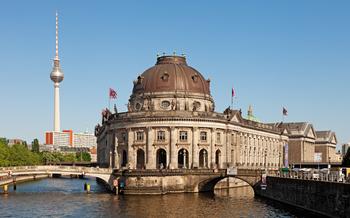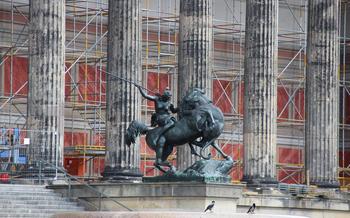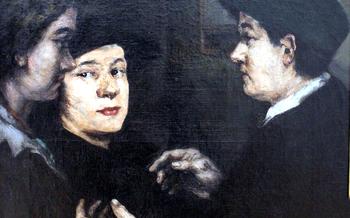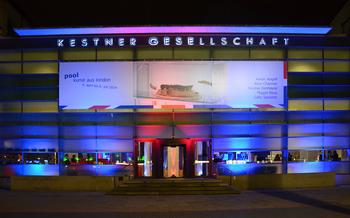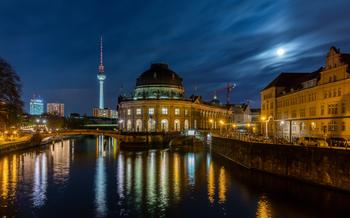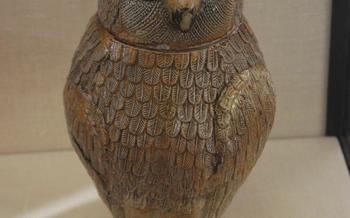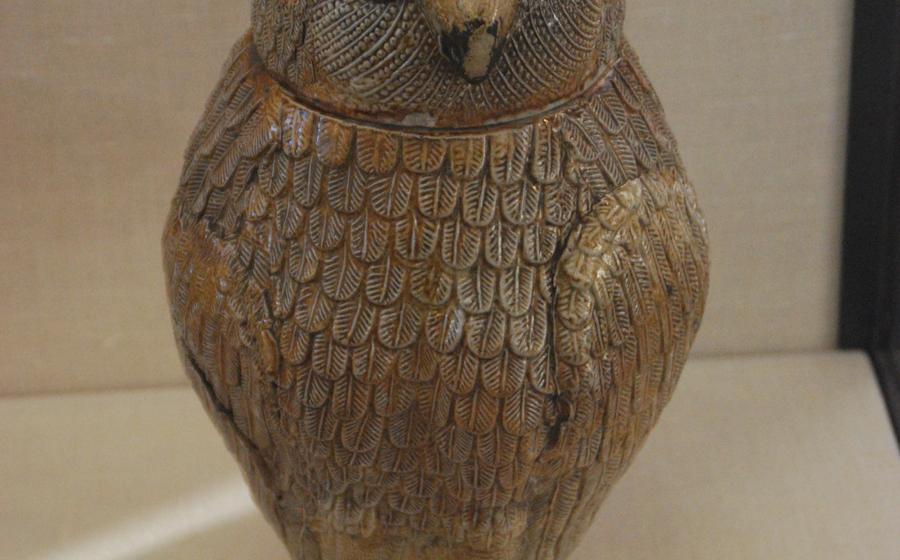
Kestner Museum
- Hanover's Hidden Gem: Unveiling the Kestner Museum
- A Journey Through Time: Exploring the Museum's History
- A Masterpiece of Architecture: Admiring the Museum's Design
- An Artful Legacy: Delving into the Museum's Collection
- Ancient Civilizations Unraveled: Exploring the Egyptian Collection
- Rediscovering Antiquity: Unveiling the Greek and Roman Collection
- A Tapestry of Applied Arts: Exploring the Museum's Craftsmanship
- Artistic Expressions: Admiring the Paintings and Sculptures
- German Expressionism in Focus: Exploring the Museum's Highlights
- Interactive Experiences: Engaging with the Museum's Exhibits
- Educational Programs: Enriching the Museum Experience
- Temporary Exhibitions: Showcasing Contemporary Art
- Museum Shop: Unique Souvenirs and Art-Inspired Gifts
- Accessibility and Amenities: Ensuring a Welcoming Environment
- Insider Tip: Unveiling the Hidden Courtyard
Hanover's Hidden Gem: Unveiling the Kestner Museum
Nestled in the heart of Hanover, Germany, the Kestner Museum stands as a testament to the city's rich cultural heritage. Founded in 1889, the museum is a treasure trove of art and artifacts, showcasing a diverse collection that spans ancient civilizations to contemporary masterpieces. The Kestner Museum is a hidden gem that offers visitors a unique journey through time and across cultures.
The museum's significance lies in its exceptional collection, which includes ancient Egyptian, Greek, and Roman artifacts, a remarkable array of applied arts, and a notable collection of paintings and sculptures from the Middle Ages to the present. The Kestner Museum has played a vital role in shaping Hanover's cultural landscape, becoming a beloved institution that attracts visitors from around the world.
A Journey Through Time: Exploring the Museum's History
In 1889, the Kestner Museum opened its doors to the public, marking a significant milestone in the cultural history of Hanover. The museum's founding owes much to the vision and dedication of Hermann Kestner, a passionate collector and art enthusiast. Kestner's extensive collection of antiquities, applied arts, and paintings formed the foundation of the museum, which has since grown to encompass a diverse range of artworks spanning various periods and cultures.
Over the years, the museum underwent several expansions and renovations, reflecting its growing popularity and the need for additional space to accommodate its expanding collection. In the early 20th century, the museum acquired the neighboring building, allowing for the expansion of its exhibition space and the creation of new galleries.
The Second World War left a significant impact on the museum. During the air raids on Hanover, the museum sustained severe damage, resulting in the loss of a substantial portion of its collection. However, through the tireless efforts of museum staff and the support of the community, the museum was able to rebuild and restore many of its damaged artworks.
Today, the Kestner Museum stands as a testament to the resilience and dedication of those who have worked to preserve and showcase its invaluable collection. It continues to serve as a vibrant cultural institution, offering visitors a glimpse into the rich artistic heritage of Hanover and beyond.
A Masterpiece of Architecture: Admiring the Museum's Design
The Kestner Museum stands as a testament to the architectural brilliance of its time. Designed in the Neo-Renaissance style, the building boasts an impressive façade adorned with intricate carvings, sculptures, and a grand dome. The dome, a striking feature of the museum, is reminiscent of the Italian Renaissance and adds a touch of grandeur to the building's overall appearance.
Inside, the museum's design seamlessly blends historical elements with modern touches. The grand staircase, with its sweeping curves and ornate balustrade, leads visitors to the upper floors, while the spacious galleries feature high ceilings and large windows that allow natural light to flood in. The recent renovation of the museum has incorporated modern elements, such as glass panels and steel beams, creating a harmonious balance between the old and the new.
The architectural design of the Kestner Museum is not merely an aesthetic endeavor but also holds symbolic significance. The Neo-Renaissance style, with its emphasis on classical forms and symmetry, reflects the museum's commitment to preserving and showcasing the art and culture of antiquity. The grand dome, reaching towards the sky, symbolizes the museum's aspiration to elevate and inspire visitors through the power of art.
An Artful Legacy: Delving into the Museum's Collection
The Kestner Museum boasts an extensive and diverse collection of artworks, spanning various periods and genres. Among its highlights are the impressive collection of ancient Egyptian, Greek, and Roman artifacts, as well as a renowned collection of applied arts, including furniture, glass, and ceramics. The museum also houses a notable collection of paintings and sculptures from the Middle Ages to the present, with a particular focus on German Expressionism.
The Egyptian collection is particularly impressive, showcasing a wide range of artifacts from various periods of ancient Egyptian history. Visitors can marvel at mummies, sarcophagi, and funerary objects, gaining insights into the daily life, religion, and burial practices of this ancient civilization. The collection is of great significance for understanding the culture and history of ancient Egypt.
The Greek and Roman collection, though smaller in size, is equally impressive, featuring exquisite sculptures, pottery, and mosaics. Masterpieces such as the "Hanover Centaur" and the "Kestner Athena" stand out as highlights of this collection. Through these artifacts, visitors can explore the artistic achievements and cultural influences of ancient Greece and Rome, gaining a deeper understanding of classical antiquity.
The museum's collection of applied arts offers a diverse array of objects, showcasing the skill and creativity of artisans throughout history. Highlights include Art Nouveau glass by Louis Comfort Tiffany and furniture by Bauhaus designers. Visitors can admire the intricate craftsmanship and innovative designs of these objects, gaining insights into the history of German craftsmanship and design.
Finally, the collection of paintings and sculptures spans a wide range of periods and styles, from the Middle Ages to the present. Notable works by German Expressionists, such as Ernst Ludwig Kirchner and Emil Nolde, are particularly noteworthy. Through these artworks, visitors can explore the emotional intensity and subjective perspectives characteristic of Expressionism, gaining a deeper understanding of this influential artistic movement.
Ancient Civilizations Unraveled: Exploring the Egyptian Collection
The Kestner Museum houses an impressive collection of Egyptian artifacts, spanning various periods and offering a glimpse into the rich culture and history of ancient Egypt. From awe-inspiring mummies and intricately carved sarcophagi to everyday objects and funerary items, the collection provides a comprehensive exploration of ancient Egyptian life, religion, and burial practices.
Highlights of the Egyptian collection include a well-preserved mummy from the 21st Dynasty, showcasing the advanced mummification techniques of the ancient Egyptians. Elaborately decorated sarcophagi and canopic jars offer insights into the beliefs surrounding the afterlife and the importance of preserving the body for the journey into the next realm.
Beyond the iconic mummies and sarcophagi, the collection also features a wealth of artifacts that illuminate the daily lives of ancient Egyptians. These include tools, pottery, jewelry, and objects used in religious rituals, providing a glimpse into their domestic, economic, and spiritual practices.
The significance of the Kestner Museum's Egyptian collection lies in its ability to transport visitors back in time, allowing them to connect with the ancient civilization and gain a deeper understanding of their beliefs, customs, and artistic achievements. It offers a unique opportunity to explore the mysteries and wonders of ancient Egypt, right in the heart of Hanover.
Rediscovering Antiquity: Unveiling the Greek and Roman Collection
In the heart of the Kestner Museum, a treasure trove of ancient artifacts awaits, whispering tales of civilizations past. The Greek and Roman collection, a testament to the artistic prowess and cultural legacy of these storied empires, invites visitors on a journey through time. Exquisite sculptures, finely crafted pottery, and intricate mosaics transport you back to the grandeur of antiquity.
Among the highlights of the collection is the "Hanover Centaur," a captivating sculpture that embodies the mythical creature with remarkable detail and grace. Its lifelike features and dynamic posture seem to capture the moment of transition between man and beast. Another masterpiece, the "Kestner Athena," radiates divine presence with her majestic stance and intricate helmet, a symbol of wisdom and strength.
Through these artifacts, the Kestner Museum offers a glimpse into the artistic achievements and cultural influences of ancient Greece and Rome. From the serene beauty of Greek pottery to the monumental grandeur of Roman mosaics, the collection provides a comprehensive exploration of classical antiquity. It's an opportunity to witness firsthand the enduring legacy of these ancient civilizations and marvel at their contributions to the foundations of Western art and culture.
A Tapestry of Applied Arts: Exploring the Museum's Craftsmanship
The Kestner Museum boasts a diverse and impressive collection of applied arts, showcasing the exceptional craftsmanship and artistry of various periods. From the intricate designs of medieval furniture to the innovative creations of Bauhaus designers, the museum's collection offers a journey through the history of German craftsmanship.
Highlights of the applied arts collection include Art Nouveau glass by Louis Comfort Tiffany, renowned for its vibrant colors and intricate patterns. The museum also houses a significant collection of furniture by Bauhaus designers, such as Marcel Breuer and Ludwig Mies van der Rohe, representing the modernist movement's emphasis on functionality and simplicity.
Visitors can admire the skill and creativity of artisans throughout history as they explore the museum's collection of ceramics and metalwork. From delicate porcelain figurines to intricate silverwork, these objects showcase the technical prowess and artistic vision of their makers.
Artistic Expressions: Admiring the Paintings and Sculptures
The Kestner Museum boasts a notable collection of paintings and sculptures spanning various periods, from the Middle Ages to the present day. These artworks provide a comprehensive overview of the evolution of artistic styles and techniques, offering visitors a captivating journey through the history of art.
Among the highlights of the collection are works by German Expressionists, a movement that emerged in the early 20th century and sought to convey emotional intensity and subjective perspectives through art. Expressionist paintings often feature bold colors, distorted forms, and exaggerated expressions, reflecting the tumultuous times in which they were created.
The museum's collection includes works by key figures of the movement, such as Ernst Ludwig Kirchner, Emil Nolde, and Franz Marc. Kirchner's vibrant and emotive paintings, such as "Street Scene, Berlin" (1913), capture the energy and chaos of urban life. Nolde's powerful and expressive works, like "The Prophet" (1912), convey a sense of spiritual and emotional turmoil. Marc's colorful and imaginative paintings, such as "Blue Horse I" (1911), explore the relationship between humans and animals and the natural world.
In addition to Expressionist works, the museum also houses sculptures from various periods, including Gothic, Renaissance, and Baroque. These sculptures showcase the skill and artistry of sculptors throughout history, from the intricate details of Gothic carvings to the dynamic forms of Baroque masterpieces.
The Kestner Museum's collection of paintings and sculptures offers visitors the opportunity to explore the diverse range of artistic expressions and styles that have shaped the history of art. Whether you are drawn to the emotional intensity of Expressionism, the technical mastery of Renaissance sculptures, or the grandeur of Baroque masterpieces, the museum's collection has something to offer everyone.
German Expressionism in Focus: Exploring the Museum's Highlights
The Kestner Museum houses an extensive collection of German Expressionist paintings and sculptures, making it a must-visit destination for enthusiasts of this influential artistic movement. Key figures such as Franz Marc, Erich Heckel, and Ernst Ludwig Kirchner are well-represented, allowing visitors to delve into the emotional intensity and subjective perspectives that characterize Expressionism.
One of the highlights of the collection is Kirchner's "Street in Berlin," a vibrant cityscape that captures the energy and chaos of modern urban life. The bold colors and exaggerated forms convey the artist's emotional response to the city, creating a sense of urgency and dynamism.
Another notable work is Heckel's "Roquairol," a portrait of a young man that exemplifies the Expressionist tendency to distort and fragment the human form. The sitter's angular features and intense gaze convey a sense of inner turmoil, reflecting the psychological and emotional struggles of the individual in a rapidly changing world.
The Kestner Museum's collection of German Expressionist art provides a comprehensive overview of this groundbreaking movement. Visitors can trace the development of Expressionism from its early roots to its more mature and complex forms, gaining a deeper understanding of its artistic and cultural significance.
Interactive Experiences: Engaging with the Museum's Exhibits
The Kestner Museum goes beyond traditional displays, offering interactive experiences that engage visitors of all ages. Interactive displays and multimedia presentations are scattered throughout the museum, allowing visitors to delve deeper into the stories behind the artifacts. Hands-on learning and exploration are encouraged, with opportunities for visitors to touch, feel, and interact with certain exhibits.
Families and children are particularly drawn to the museum's interactive offerings. Activity stations and workshops are designed to spark curiosity and creativity, making the museum a fun and educational experience for the whole family. These interactive elements not only enhance the museum experience but also foster a deeper understanding and appreciation of art and culture.
Educational Programs: Enriching the Museum Experience
The Kestner Museum offers a range of educational programs to enhance the visitor experience and promote a deeper understanding of art and culture. Guided tours, led by knowledgeable docents, provide insights into the museum's collection and its historical significance. These tours are available for groups and individuals, and can be tailored to specific interests and themes.
In addition to guided tours, the museum organizes lectures, workshops, and educational programs on a variety of topics related to art history, archaeology, and museology. These programs are designed to appeal to a wide audience, from art enthusiasts to students and researchers. Through lectures by experts in their fields, participants gain a deeper understanding of the museum's collection and the broader cultural context in which it exists.
The Kestner Museum also collaborates with schools and universities to promote art education and foster a love of art among younger generations. Educational programs for school groups include interactive workshops, hands-on activities, and guided tours tailored to the curriculum. The museum also works with universities to offer internships and research opportunities for students pursuing careers in art history and museum studies.
Overall, the educational programs at the Kestner Museum provide visitors with the opportunity to engage with the museum's collection in a meaningful way, deepen their understanding of art and culture, and foster a lifelong appreciation for the arts.
Temporary Exhibitions: Showcasing Contemporary Art
The Kestner Museum not only houses a remarkable permanent collection but also presents a diverse range of temporary exhibitions that showcase contemporary art from around the world. These exhibitions provide a platform for emerging artists to showcase their work and offer visitors the opportunity to engage with current trends in the art world. The museum collaborates with galleries and institutions to present a wide range of perspectives, allowing visitors to experience the vitality and diversity of contemporary art.
Temporary exhibitions often focus on specific themes or movements, delving into the artistic expressions of particular periods or regions. They offer visitors the chance to explore new ideas, discover new artists, and gain insights into the latest developments in the art world. The museum's commitment to presenting contemporary art ensures that visitors have access to a dynamic and ever-changing artistic landscape, fostering dialogue and exchange on the most pressing issues and trends in the contemporary art scene.
Museum Shop: Unique Souvenirs and Art-Inspired Gifts
The Kestner Museum houses a well-stocked museum shop, providing visitors with an opportunity to take home a piece of the art experience. The shop offers a diverse range of art-related merchandise, including books, prints, postcards, and reproductions of artworks. These items allow visitors to delve deeper into the museum's collection and keep their favorite pieces close at hand.
Unique souvenirs and gifts inspired by the museum's collection are also available in the shop. These items, such as jewelry, pottery, and home décor, are carefully curated to reflect the museum's artistic legacy. By purchasing these souvenirs, visitors not only support the museum but also take home a tangible reminder of their visit.
The museum shop is strategically located near the exit, making it convenient for visitors to browse and purchase items before departing. Its friendly staff is always ready to assist with recommendations and provide information about the various products. Whether you are looking for a gift for a loved one or a memento for yourself, the Kestner Museum shop offers a treasure trove of unique and meaningful items.
Accessibility and Amenities: Ensuring a Welcoming Environment
The Kestner Museum is dedicated to creating an inclusive and welcoming environment for all visitors. Wheelchair accessibility and ramps are available throughout the museum, ensuring that everyone can easily navigate the galleries and exhibitions. Family-friendly facilities, including strollers and baby-changing stations, make it easy for parents to enjoy the museum with their young children.
For international visitors, the museum provides audio guides and multilingual materials to enhance their understanding of the exhibits. A café and restaurant offer refreshments and light meals, providing a convenient option for visitors to refuel during their visit. These amenities ensure that everyone can comfortably explore and appreciate the museum's diverse collection.
Insider Tip: Unveiling the Hidden Courtyard
Amidst the bustling streets of Hanover, the Kestner Museum holds a secret sanctuary—a hidden courtyard that offers a tranquil oasis for visitors to relax and rejuvenate. Tucked away from the main galleries, this charming space invites you to slow down and appreciate the beauty of nature and art.
Stroll through the courtyard and admire the sculptures that adorn its corners, each telling a unique story. The gentle sound of water trickling from a fountain creates a serene atmosphere, while the lush greenery provides a splash of color and life.
Find a bench to sit down and take a break from the hustle and bustle of the city. Enjoy a picnic lunch surrounded by art and nature, or simply close your eyes and listen to the sounds of the courtyard.
This hidden gem is a perfect spot to escape the crowds and find a moment of peace and reflection. Whether you're an art enthusiast or simply looking for a tranquil retreat, the inner courtyard of the Kestner Museum is a must-visit for anyone exploring Hanover.
